Santos Bundle
How has the Santos Company shaped Australia's energy future?
Embark on a journey through time to uncover the Santos Company's remarkable evolution. From its humble beginnings in 1954, this Australian oil and gas pioneer has become a key player in the Asia-Pacific region. Explore the Santos Company's brief history, its strategic foresight, and its impact on the global energy landscape.
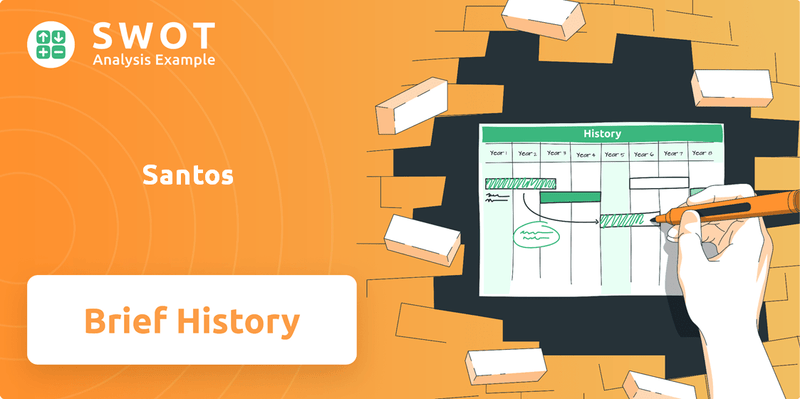
This exploration will reveal the Santos Company's origins, key milestones, and the challenges it overcame. Understanding the Santos business and its growth trajectory provides critical insights into the dynamics of the energy sector. Discover how this company has evolved, its historical achievements, and its current status within the industry.
What is the Santos Founding Story?
The Santos Company history begins on March 18, 1954, when it was officially incorporated in Adelaide, South Australia. This marked the start of a significant venture into Australia's energy sector. The company's early focus was on exploring the vast potential of oil and gas reserves within the Australian outback, addressing the nation's need for domestic energy sources.
The brief history of Santos is a story of pioneering spirit and strategic foresight. It was a collective effort by individuals who saw an opportunity to reduce Australia's dependence on imported fuels. The initial goal was to discover commercially viable oil and gas fields, a critical step towards energy self-sufficiency.
The Santos Company's origins are rooted in the post-World War II era, a time of industrialization and a strong push for energy independence within Australia. The company's inception was driven by the need to find domestic hydrocarbon production. This need presented a significant opportunity for pioneering exploration companies.
The company's name, 'Santos,' is an acronym for South Australian Northern Territory Oil Search, reflecting its initial geographical and operational focus. Early funding came from private investors and government support, highlighting the strategic importance of energy self-sufficiency.
- The primary goal was to explore for oil and gas.
- Early challenges included logistical difficulties, high capital intensity, and the risks of hydrocarbon drilling.
- The initial business model focused solely on exploration.
- The first significant 'product' was the promise of future energy resources.
Santos SWOT Analysis
- Complete SWOT Breakdown
- Fully Customizable
- Editable in Excel & Word
- Professional Formatting
- Investor-Ready Format
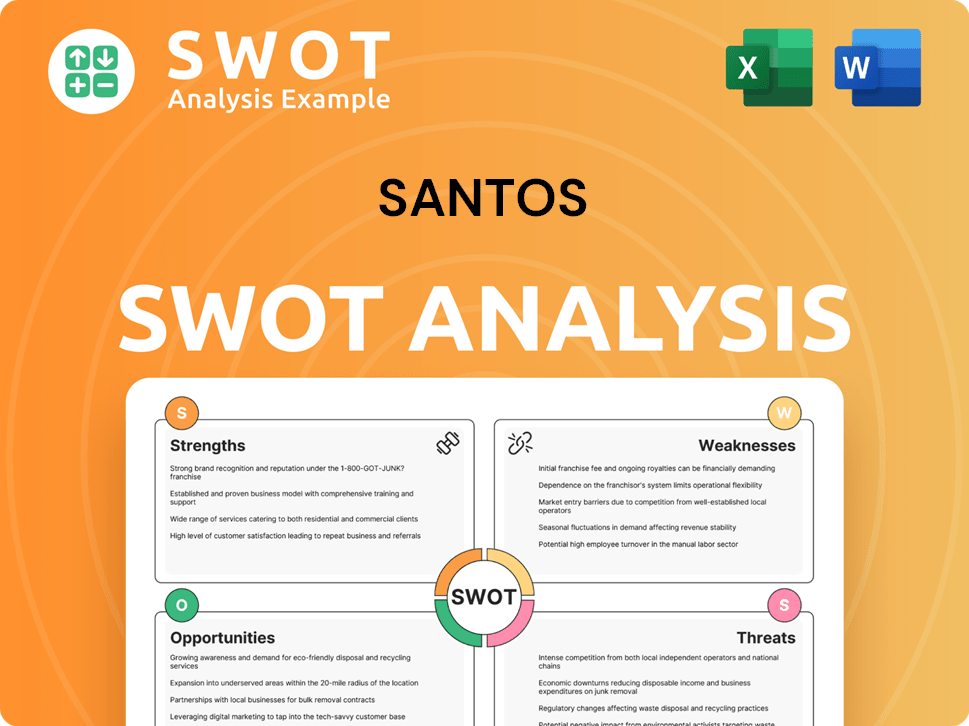
What Drove the Early Growth of Santos?
The early growth of the company, now known as the Santos Company, was significantly shaped by its exploration successes in the Cooper Basin. The discovery of the Gidgealpa gas field in 1963 and the Moomba gas field in 1966 were pivotal, transitioning the company from a speculative explorer to an active producer. This period marked the beginning of commercial operations, setting the stage for its future as a major player in the energy sector. To understand more, you can read about the Growth Strategy of Santos.
The Gidgealpa gas field discovery in 1963 and the Moomba gas field in 1966 were critical milestones. These discoveries enabled the company to move from exploration to production. The development of these fields was essential to its early commercial success and future growth.
The company's commercial operations began after the gas field discoveries. Long-term contracts with Adelaide in 1969 and Sydney in 1976 were key to establishing a reliable gas supply. These contracts were fundamental in securing a consistent revenue stream.
The company expanded its team to manage field development, gas processing, and pipeline construction. Office locations were primarily in Adelaide, with operational bases near the Cooper Basin fields. This expansion was crucial for supporting the growing infrastructure.
Entry into new markets was driven by the expansion of its gas pipeline network. By the 1980s, the company began diversifying beyond the Cooper Basin, exploring in the Carnarvon Basin. This diversification was supported by strategic capital raises.
Santos PESTLE Analysis
- Covers All 6 PESTLE Categories
- No Research Needed – Save Hours of Work
- Built by Experts, Trusted by Consultants
- Instant Download, Ready to Use
- 100% Editable, Fully Customizable
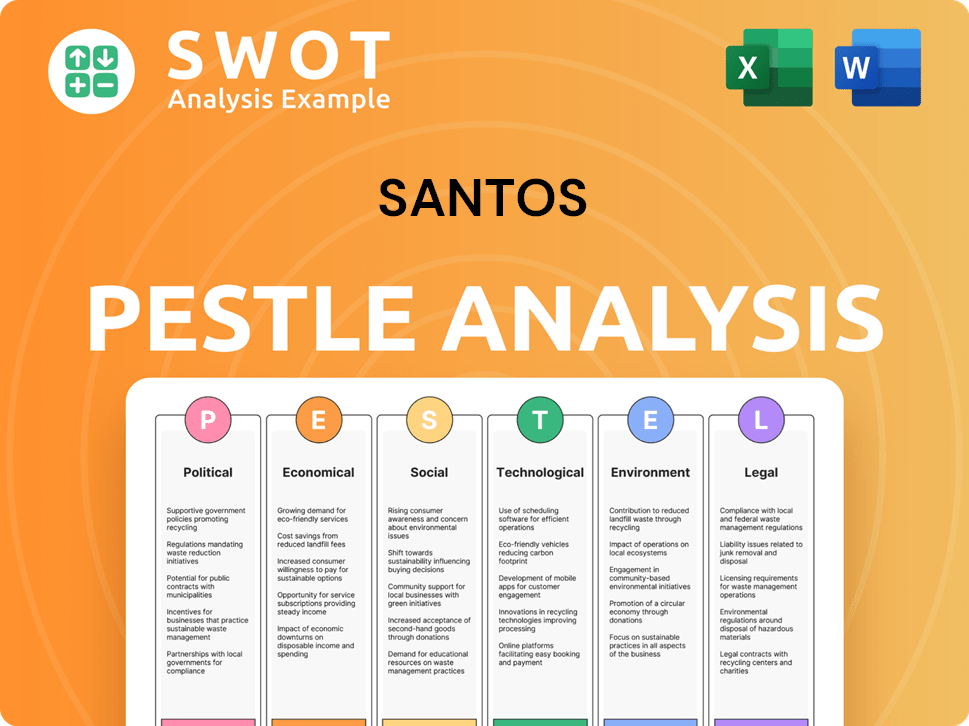
What are the key Milestones in Santos history?
The Santos Company history is marked by significant milestones that have shaped its trajectory in the energy sector. From its early origins to its current status as a major player, Santos has consistently adapted and innovated to meet the evolving demands of the market.
| Year | Milestone |
|---|---|
| 1954 | Founded as South Australian Northern Territory Oil Search. |
| 1969 | Developed the Cooper Basin Unit Agreement, a pioneering joint venture model. |
| 2000s | Expanded significantly through major projects like Darwin LNG and GLNG. |
| 2020 | Committed to a 30% reduction in Scope 1 and 2 emissions by 2030 (from 2020 baseline). |
| 2024 | Continues to focus on strategic portfolio optimization and ESG initiatives. |
Throughout its Santos business journey, innovation has been a key driver of success. The company has consistently adopted advanced technologies to improve operational efficiency and unlock new reserves, ensuring its position in the competitive energy market.
Employed advanced seismic imaging techniques to identify and assess potential reserves, enhancing exploration success rates.
Developed and implemented innovative drilling techniques to access previously inaccessible reserves, increasing production capacity.
Utilized advanced technologies in Liquefied Natural Gas (LNG) projects to improve efficiency and reduce operational costs.
Invested in digital transformation initiatives to optimize operations, improve decision-making, and enhance safety across its assets.
Exploring and implementing carbon capture and storage (CCS) technologies to reduce emissions and support sustainability goals.
Implementing data analytics and automation to streamline processes and improve production efficiency across its various operations.
The Santos Company has faced numerous challenges, including market volatility and environmental concerns. Strategic adjustments and a focus on sustainability have been crucial in navigating these obstacles and ensuring long-term viability.
Navigated fluctuating oil and gas prices, requiring strategic financial planning and operational flexibility to maintain profitability.
Adapted to competition from both traditional energy companies and the rise of renewable energy sources by diversifying its portfolio and investing in cleaner energy solutions.
Addressed increasing environmental concerns and regulatory requirements by implementing robust sustainability practices and emissions reduction targets.
Managed the complexities of large-scale projects, ensuring efficient execution and cost management to maximize returns on investment.
Mitigated risks associated with geopolitical instability in regions where it operates, ensuring operational continuity and asset protection.
Maintained capital discipline through strategic portfolio optimization and divestments, ensuring financial stability and sustainable growth.
Santos Business Model Canvas
- Complete 9-Block Business Model Canvas
- Effortlessly Communicate Your Business Strategy
- Investor-Ready BMC Format
- 100% Editable and Customizable
- Clear and Structured Layout
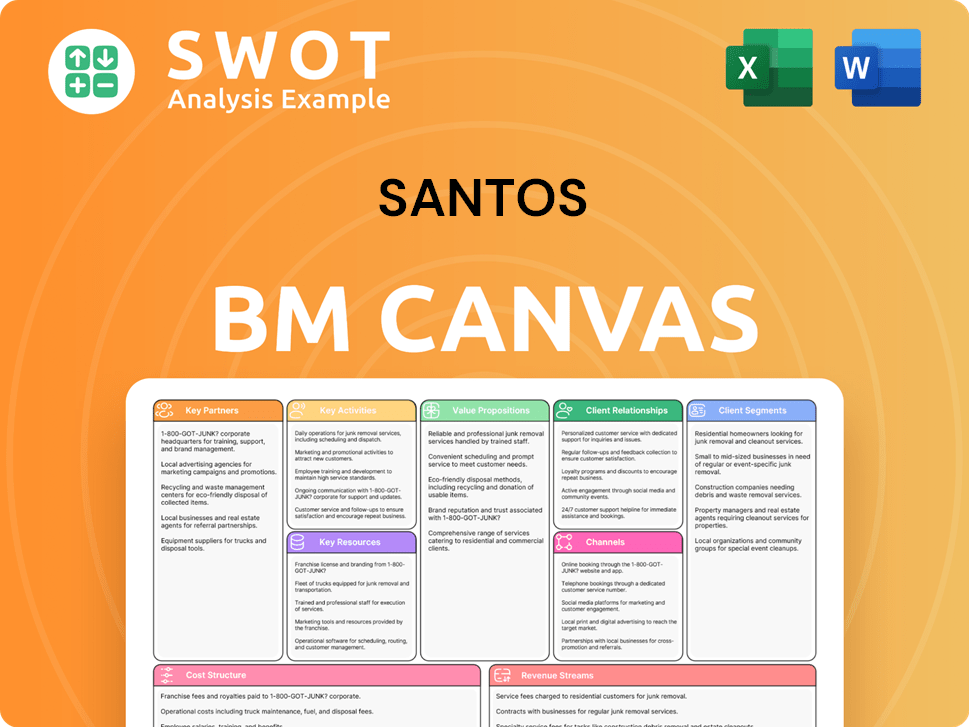
What is the Timeline of Key Events for Santos?
The brief history of Santos Company is marked by significant milestones that have shaped its development into a leading energy provider. From its origins in 1954 to its current status, the company has consistently adapted to market changes and expanded its operations. Key events include major gas discoveries, strategic acquisitions, and large-scale project investments, all contributing to its growth and impact on the energy sector.
| Year | Key Event |
|---|---|
| 1954 | Santos Limited was incorporated, marking the company's founding. |
| 1963 | The Gidgealpa gas field was discovered in the Cooper Basin. |
| 1966 | The Moomba gas field discovery further solidified the potential of the Cooper Basin. |
| 1969 | First commercial gas sales from the Cooper Basin commenced, supplying Adelaide. |
| 1976 | Gas supply to Sydney began, expanding market reach. |
| 1980s | Exploration efforts diversified beyond the Cooper Basin. |
| 2000s | Significant expansion into LNG projects, including Darwin LNG, took place. |
| 2011 | The final investment decision for the GLNG project in Queensland was made. |
| 2018 | Acquisition of Quadrant Energy significantly boosted Western Australian assets. |
| 2021 | Merger with Oil Search created a leading regional energy company. |
| 2023 | Santos achieved record production of 93.1 million barrels of oil equivalent (mmboe) and record sales volumes of 105.2 mmboe. |
| 2024 | Santos continues its 'Decade of Deliver' strategy, focusing on optimizing existing assets and pursuing growth projects in the Asia-Pacific region. |
| 2025 | Anticipated continued progress on key projects such as the Dorado oil project and the Narrabri Gas Project, subject to regulatory approvals and market conditions. |
Santos's future hinges on its 'Decade of Deliver' strategy, which prioritizes optimizing existing assets and pursuing growth opportunities in the Asia-Pacific region. This includes a strong emphasis on LNG projects. The company aims to enhance shareholder value through disciplined capital allocation and operational excellence. This strategy is designed to ensure sustainable growth and profitability.
Decarbonization is a key focus for Santos, involving carbon capture and storage (CCS) projects to reduce emissions. The company is investing in technologies and initiatives to lower its carbon footprint. These efforts align with global trends towards cleaner energy sources. They are essential for long-term sustainability and responsible resource management.
Santos is focused on expanding its presence in Asia, a region with growing energy demand, particularly for natural gas. The company aims to meet the increasing energy needs of Asian countries. This expansion strategy is crucial for long-term growth. It capitalizes on the transition towards natural gas as a cleaner fuel.
Industry trends, such as the push for lower-carbon energy, will significantly impact Santos's future. Analyst predictions suggest Santos will play a crucial role in regional energy supply. The company's ability to balance traditional hydrocarbon production with investments in sustainable energy solutions will be key. This balance is crucial for long-term success.
Santos Porter's Five Forces Analysis
- Covers All 5 Competitive Forces in Detail
- Structured for Consultants, Students, and Founders
- 100% Editable in Microsoft Word & Excel
- Instant Digital Download – Use Immediately
- Compatible with Mac & PC – Fully Unlocked
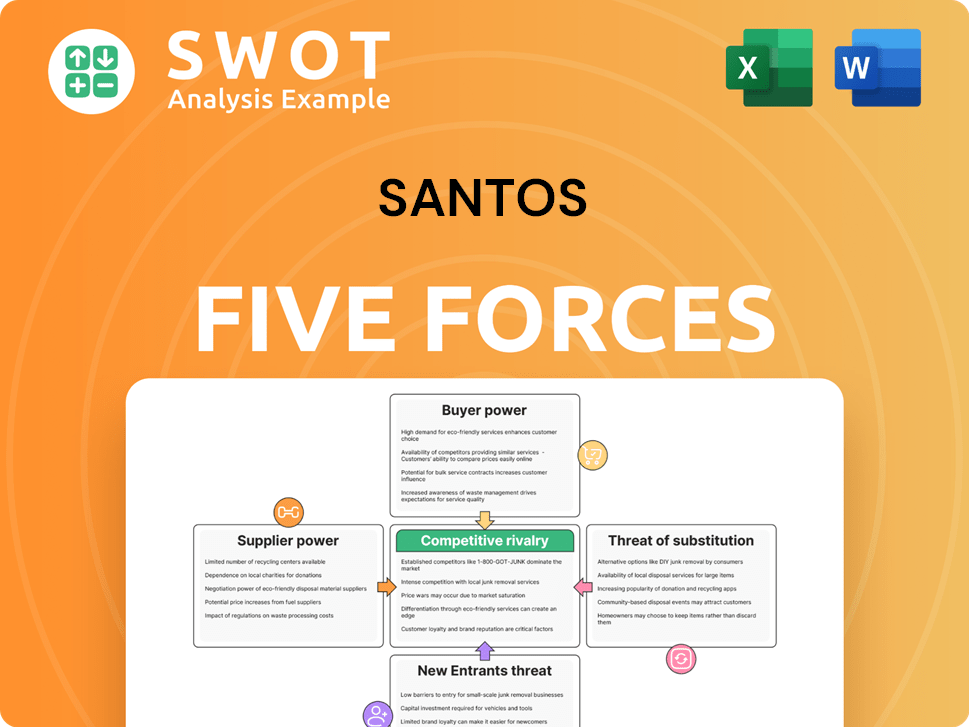
Related Blogs
- What is Competitive Landscape of Santos Company?
- What is Growth Strategy and Future Prospects of Santos Company?
- How Does Santos Company Work?
- What is Sales and Marketing Strategy of Santos Company?
- What is Brief History of Santos Company?
- Who Owns Santos Company?
- What is Customer Demographics and Target Market of Santos Company?
Disclaimer
All information, articles, and product details provided on this website are for general informational and educational purposes only. We do not claim any ownership over, nor do we intend to infringe upon, any trademarks, copyrights, logos, brand names, or other intellectual property mentioned or depicted on this site. Such intellectual property remains the property of its respective owners, and any references here are made solely for identification or informational purposes, without implying any affiliation, endorsement, or partnership.
We make no representations or warranties, express or implied, regarding the accuracy, completeness, or suitability of any content or products presented. Nothing on this website should be construed as legal, tax, investment, financial, medical, or other professional advice. In addition, no part of this site—including articles or product references—constitutes a solicitation, recommendation, endorsement, advertisement, or offer to buy or sell any securities, franchises, or other financial instruments, particularly in jurisdictions where such activity would be unlawful.
All content is of a general nature and may not address the specific circumstances of any individual or entity. It is not a substitute for professional advice or services. Any actions you take based on the information provided here are strictly at your own risk. You accept full responsibility for any decisions or outcomes arising from your use of this website and agree to release us from any liability in connection with your use of, or reliance upon, the content or products found herein.